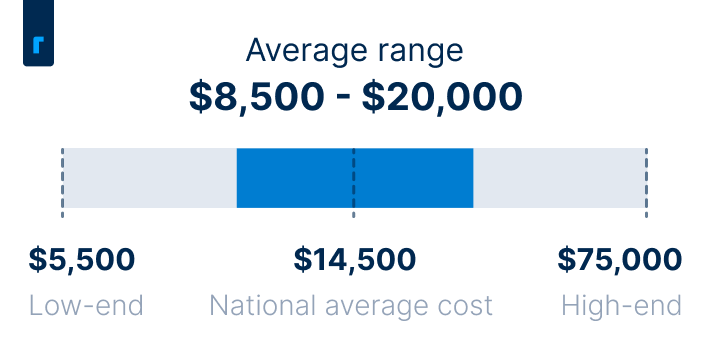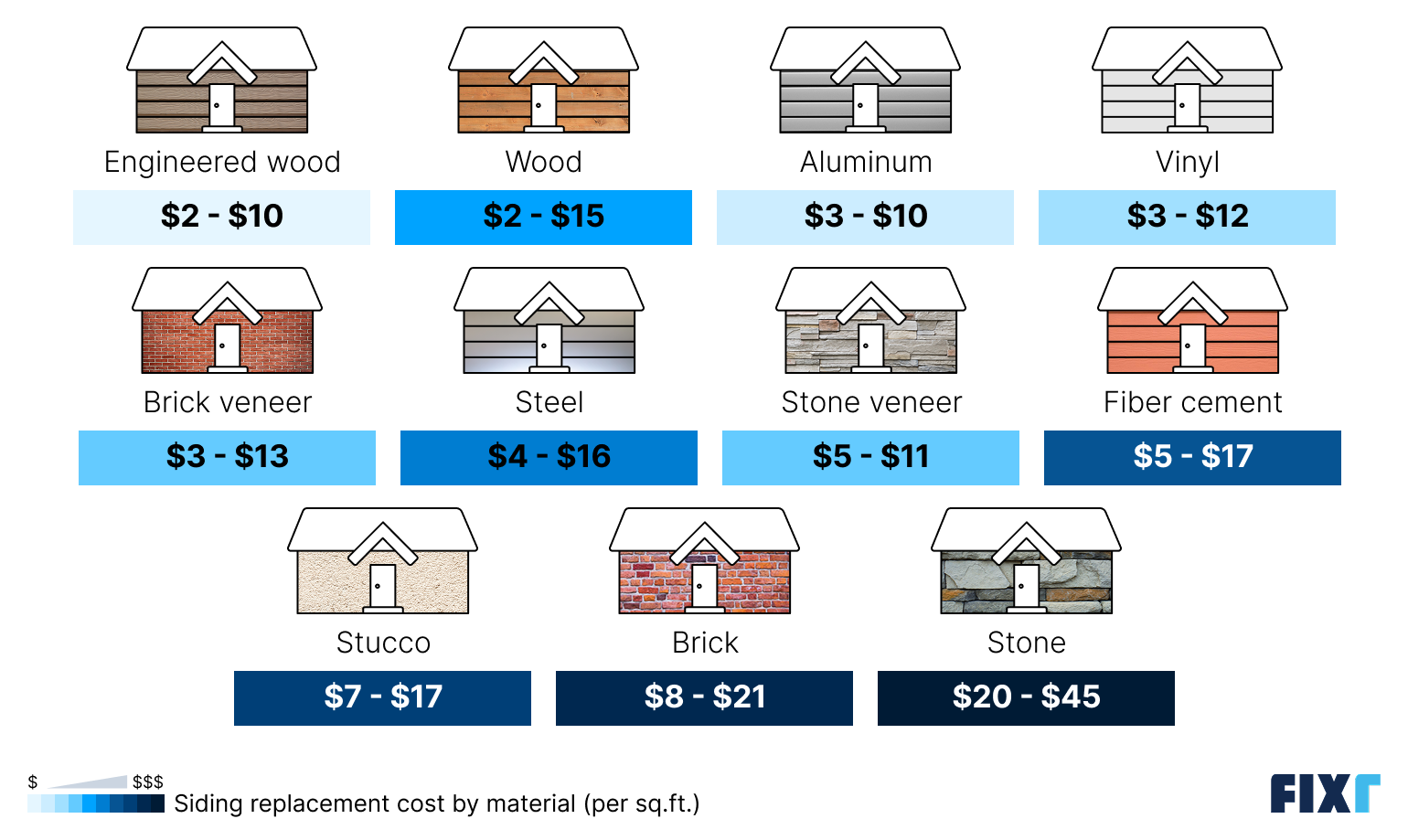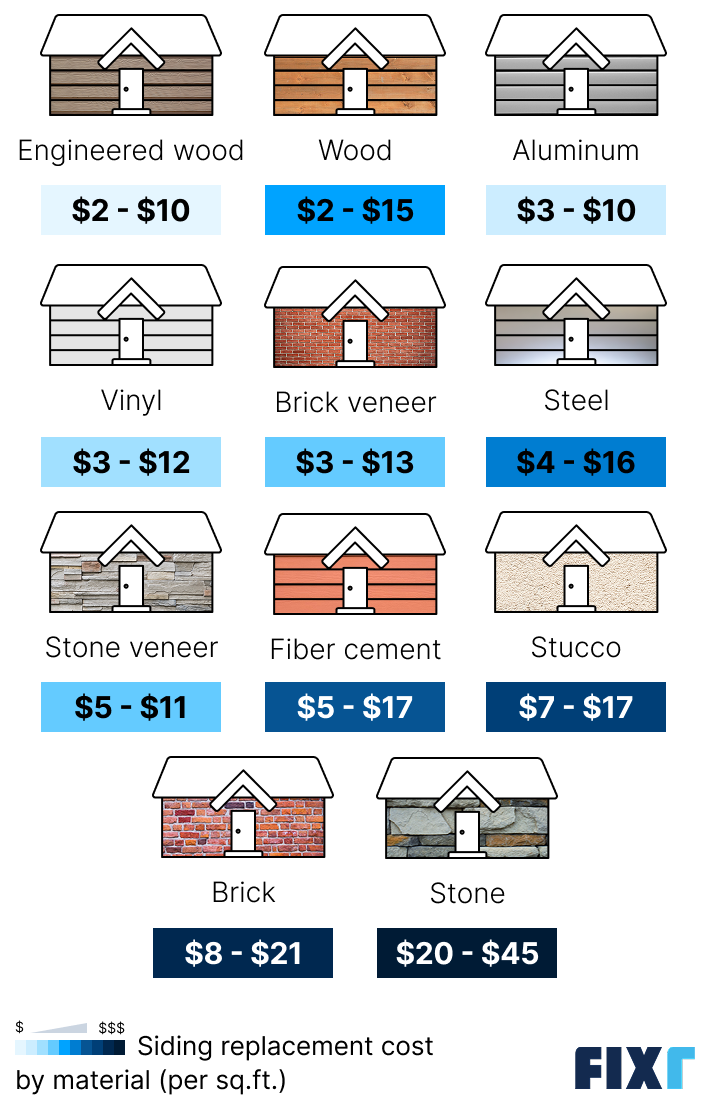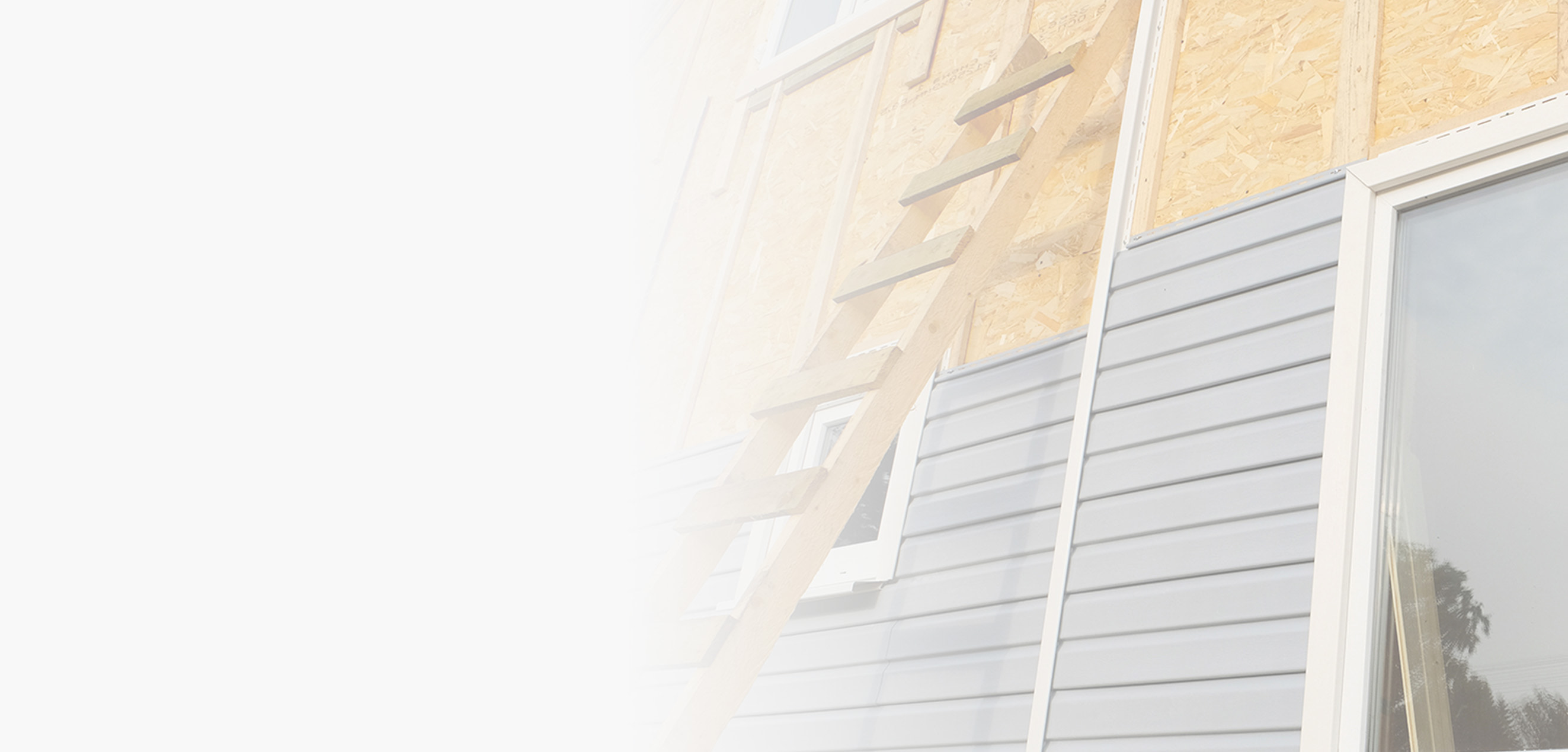Updated: November 18, 2025
Written by Dan Simms
Nieves is a home remodeling editor at Fixr.com with special interest in landscaping, pest control, painting, installation, and repair projects. She brings her work ethic, creativity, and love for teamwork into everything she does, including working with writers and designers at Fixr.com to develop useful and comprehensive guides for homeowners.
Learn moreReviewed by Nieves Martinez
Siding is one of your home’s primary defenses against the elements, as well as a primary driver of curb appeal. Replacing siding means reducing the risk of leaks and water damage, and it will make your home more visually appealing, valuable, and, in many cases, energy-efficient.
The average cost of a siding project a house is $14,500 for a 2,000 sq.ft. house, with most projects costing between $8,500 and $20,000. Pricing depends mostly on the type of siding you choose and the size of your home, but your location, existing siding material, and layout of your home can also affect your project costs.
House Siding Cost


Key Factors That Influence Siding Replacement Cost
There are a few important factors that can influence home siding replacement costs, so be sure to consider all of these to get an accurate cost estimate for your project.
Home size: Most siding contractors will charge by the square foot for materials and labor, which means larger homes with a bigger footprint and multiple stories will always cost more.
Siding material: Siding materials range from around $2 per square foot for some engineered wood products to $45 per square foot for genuine stone, so the siding material you pick is a primary driver of cost.
Location: Labor costs vary by location, usually in relation to the local cost of living. Location and climate can also dictate which materials are best in your area, which can affect average costs.
Installation complexity: A perfectly rectangular or square home will require few measurements and cuts to install siding, while a more complex layout with bumpouts will drive up labor and lead to increased material waste from cut-offs. Landscaping features that get in the way of installation can also drive up costs.
Labor: The labor cost to install siding falls between $1 and $4 per square foot, depending on the material you’re installing and how easy it is to cut and attach to your home. For example, brick and stone siding come with higher labor costs due to the masonry work, while installing vinyl siding costs closer to $1 per square foot, given how light the material is.
Removal of existing siding: Your siding contractor will charge for the siding removal of your old siding and haul away the debris. Expect to pay between $1,000 and $2,500 for this service, depending on the weight of the material and how difficult it is to remove.
Cost of Siding a House By Material
The siding material you choose is one of the most important cost factors to consider, as different materials range from $2 to $45 per square foot. Some wood and engineered wood siding can cost as little as $2 per square foot, while high-end options like real brick siding and stone can cost $8 to $45 per square foot.
Vinyl is the most popular siding material in the U.S. and costs between $3 and $12 per square foot, including the labor to install it. Vinyl provides excellent value, suits most climates, and requires minimal maintenance, but it offers minimal insulation and is less sustainable than most other options. Fiber cement is an increasingly popular option, as it’s relatively affordable, more sustainable than vinyl, and provides outstanding value for the money with a longer lifespan and better resistance to extreme weather. It is also a great low-maintenance material.
Brick and stone are the most expensive materials, and they’re the most luxurious and offer excellent insulation. Many homeowners instead opt for brick or stone veneer, which creates a similar high-end look for a fraction of the cost.


Material | Cost per Square Foot |
Engineered wood | $2 - $10 |
$2 - $15 | |
$3 - $10 | |
$3 - $12 | |
Brick veneer | $3 - $13 |
$4 - $16 | |
Stone veneer | $5 - $11 |
$5 - $17 | |
$7 - $17 | |
$8 - $21 | |
$20 - $45 |
Material prices can fluctuate due to demand, supply chain issues, tariffs on important goods, and regional availability. For an accurate total cost or price per square foot, get formal estimates from local siding contractors for the materials you’re considering.
Siding Replacement Cost per Square Foot
All contractors will take the size of your home into consideration, and they’ll base their totals on the square footage of siding you need and the siding materials you choose. Including labor and material costs, you can expect to pay an average of $3 to $15 per square foot, depending on the material you choose. You can use this price range and then calculate how many square feet of siding you need to cover your home to get an accurate estimate.
Average Cost of Siding a House By Size
Since house siding replacement costs are based largely on the square feet of siding you need, your home size will play an important role in your total costs. For example, the cost to replace siding on a 2,000-square-foot house is always going to be more than the cost for a 1,000-square-foot house, although you’ll have to plan for differences in wall openings and layout, too. You can start by using a siding calculator to determine how much siding you need for your home.
For the most accurate estimate of square footage, measure the length and width of all of your exterior walls, add them together, and then subtract the total square footage taken up by your windows and doors. Alternatively, you can use the table below to get an idea of how much siding you need, but keep in mind that the layout and the number of stories will affect the square footage you need, too.
Home Size (Square Feet) | Square Feet of Siding Needed | Average Cost Range |
1,000 | 1,200 - 1,300 | $3,600 - $19,500 |
1,200 | 1,400 - 1,600 | $4,200 - $24,000 |
1,500 | 1,600 - 1,800 | $4,800 - $27,000 |
2,000 | 1,800 - 2,000 | $5,400 - $30,000 |
2,500 | 2,000 - 2,200 | $6,000 - $33,000 |
3,000 | 2,300 - 2,500 | $6,900 - $37,500 |
Siding Installation Labor Cost
On average, you can expect labor to account for between $1 and $4 per square foot of siding you need installed. For the average home, the labor for siding installation costs comes to between $1,800 and $8,000. While many siding contractors bid on a per-square-foot basis, some may charge based on the time your project will take, with costs ranging from $40 to $90 per hour.
The price you’ll pay for labor will vary based on the complexity of the installation and the material, as some materials, like stucco, brick, and stone, are much more challenging and labor-intensive to install.
Additional Factors Affecting the Cost of Siding Replacement
The material you choose and your local labor costs are the most significant cost factors to consider, but there are other things that can influence your pricing. For the most accurate estimate possible, be sure to consider the following in addition to home square footage and siding materials.
Structural Repairs
When your siding contractor starts removing your old siding, there’s a chance they’ll discover water damage, wood rot, or damage from wood-destroying insects. You’ll need to address these problems before you can install the new siding. Repairs for hidden damages can add hundreds or even thousands to your total siding replacement costs, especially if the damage is extensive enough to create structural issues.
Unfortunately, it’s hard to plan for hidden damages, but if your existing siding is well beyond its useful lifespan, or you’re replacing your siding because you’ve seen evidence of leaks inside, it’s wise to budget for repairing hidden damage, too.
Permits and Inspections
Most municipalities require permits for siding replacement, and you’ll have to pay the associated permit and inspection fees to keep your project legal and up to code. Permits for siding replacement cost between $150 and $1,500, in most cases, but your costs will be determined by your local building department. Ask your siding contractor or your building department how much permits cost to get an idea of how much you should budget.
Finishing Costs and Accessories
Many siding contractors will include the cost of exterior trim around doors and windows, but some won’t, so you may need to budget extra for these finishes. Depending on the material, the addition of trim alone can add between $0.50 and $30 per linear foot.
Depending on the state of your home’s exterior, you may also want to budget for other upgrades, like replacing soffits, fascia, gutters and downspouts, and flashing. These will all vary based on materials, home size, and local labor costs.
Add-on | Average Cost |
$4 - $40/linear foot | |
Soffit replacement | $6 - $30/linear foot |
Fascia replacement | $7 - $22/linear foot |
$400 - $1,200 (each) | |
$500 - $2,400 |
Siding Style and Design
The style and design of the siding you choose to install will affect your pricing, too. Most homeowners choose a simple and understated horizontal lap siding, so the average cost of siding replacement mostly includes this design. You could pay more for diagonal lap siding, due to increased material waste and labor costs, as well as for something like board and batten siding, which demands more labor and additional materials.
You’ll also pay more for custom colors, especially if you go with fiber cement siding that often has the coloring pigments embedded in the actual material. If you’re opting to paint your siding along with the installation, you should budget an additional $1 to $6 per square foot.
Increased Demand for Energy-Efficient Siding
Utility costs are on the rise, and many homeowners are responding by opting for energy-efficient home improvements that help keep heating and cooling costs to a minimum. Siding plays a role in your home’s overall insulation, so you may want to consider the value of upgrading your siding with insulation in mind. You can either choose a more insulating material or add rigid foam insulation behind your siding. These options will both increase your siding replacement costs, but you could end up saving money in the long run due to improved energy efficiency.
Time of Year
Finally, when you decide to schedule your siding replacement project will affect your costs. Siding contractors are usually busiest in the late spring and early summer, so you could save some money on labor due to decreased demand in the fall or early winter. Be sure to consider material cost fluctuations, too, as they could add to or detract from your savings.
Siding Repair vs. Replacement
In most cases, siding repair costs between $2 and $20 per square foot, which puts it on par with siding replacement costs. However, in most cases, you’ll only need a small section of siding repaired, which means repairs should cost much less than total replacement. Siding repair is probably a good option if you have small cracks or isolated damages from impact, but go with replacement if you have ongoing moisture problems, leaks, or your siding is failing or detracting from curb appeal due to old age.
Here are some cases when you should consider siding replacement rather than repairs:
Extensive damage: If you have widespread damage from a severe weather event, a replacement is probably a better option from a financial perspective, especially if your homeowner’s insurance will cover the costs. Even if it won’t, consider a replacement if repairs will cost 50% or more of what you’d pay for replacement.
Existing siding is reaching its useful lifespan: If your old siding will need replacement in the next 5 to 10 years anyway, you should consider jumping the gun and replacing it instead of investing in repairs. You’ll likely spend less in the long run if you splurge on a replacement now.
Your siding is causing ongoing problems: If you’ve noticed signs of siding failure, like visible leaks or poor curb appeal, or you find yourself paying for repairs routinely, consider replacing the old siding instead of repairing it. This will uncover problems like wood rot and water damage that could get worse with time, as well as fix the underlying issue.
Is Siding Replacement a Good Investment? (ROI & Value)
Siding replacement is one of the best investments you can make in terms of return on investment (ROI). The 2025 Cost vs. Value report shows that the ROI for siding can be as high as around 114% for fiber cement and 97% ROI for vinyl siding, making it a valuable upgrade in terms of what you can expect from a bump in property value. This is, in large part, due to the fact that siding plays a key role in curb appeal.
Even if you don’t plan on selling anytime soon, siding replacement could be worthwhile. Certain types of siding, including insulated vinyl siding, fiber cement, stone, stucco, and brick, will help insulate your home and can reduce heating costs in cold climates by 7% to 8%, saving up to $170 per year.
Even if your new siding doesn’t boost energy efficiency, it will reduce the risk of siding failure and will help protect your home from water and pests. Especially if you’re replacing siding that’s near or beyond its useful lifespan, the upfront cost could be well worth the investment.
DIY Siding Installation vs. Hiring a Professional
An average of between $1,800 and $8,000 of your total will go toward labor, which accounts for between $1 and $4 per square foot. Many homeowners with some DIY experience will undoubtedly wonder if DIYing siding replacement is a good option to save on labor costs. While it might seem to save you thousands of dollars upfront, it’s essential to hire a professional to get the work done properly.
Any mistakes you make during the installation can lead to expensive structural or water damage, and decreased home energy efficiency, which will cut into the savings you’d see as a result. Most manufacturers will also void your warranty if you don’t have a licensed contractor complete the installation, so problems stemming from the product itself will also be your responsibility if something goes wrong.
While professional siding installation is much more expensive than doing it yourself, it’s worth the investment to keep your home protected from the elements and maintain your product warranty.
How to Choose a Siding Contractor
Professional siding installation is almost as important as the siding material you choose to install. Proper installation technique can mean better seals and insulation that contribute to home energy efficiency, a more professional appearance that adds more to curb appeal and home value, and better protection for your structure from the elements. Here are a few tips for choosing a reliable siding contractor to get the work done:
Hire a licensed contractor: First and foremost, always hire a contractor who is licensed and insured. Going this route will cost a bit more than hiring a handyperson or fly-by-night contractor, but it will keep your product warranty intact and will lead to a lower risk of damage to your home and problems over the long term.
Check reviews and company history: Read through reviews online and check each company’s rating on the Better Business Bureau (BBB). Keep an eye out for red flags, which include complaints filed by past customers or a lack of reviews. You should also make sure you work with a contractor with at least 3 to 5 years of experience.
Ask about warranties: Ask each siding pro you’re considering about labor warranties, which some contractors don’t offer. Companies that do provide warranties for their labor are more likely to complete a professional installation with no mistakes that could lead to future property damage.
Get at least three quotes: Finally, get estimates from at least three local siding companies to compare prices. This can help you rule out contractors that come in unusually low or unreasonably high, and it can help you find the best value for your money.
How to Save Money on Siding Replacement
Siding replacement costs can get quite expensive, but there are some things you can do to help keep costs down:
Pick your materials carefully: Siding materials range from $2 to $45 per square foot, so think about your options carefully. Consider going with a mid-range option that balances upfront cost, longevity, and curb appeal for the best value.
Go with stock colors: Custom colors may suit your style best, but stock options like neutral colors are going to be the most affordable and readily available. Stick with the standard colors to keep costs as low as possible.
Choose simple styles: Lap siding is the most affordable style, so keeping things simple instead of going with potentially more appealing options, like board and batten, can help reduce your installation costs.
Time your installation properly: Siding contractors are busiest in the spring and summer, so if your local climate allows, you could save some money by opting to replace your siding in the fall or winter. This is a great time to schedule an off-season project.
Consider financing: Financing home improvement projects will almost always lead to higher all-in costs due to interest, but it can make the home upgrade attainable in terms of upfront costs. Consider exploring no-interest financing options for the best deal possible.
Look for rebates and incentives: Siding replacement may make you eligible for rebates, tax credits, and other incentives, especially if you choose a more insulating material that boosts home energy efficiency.
Think about homeowner’s insurance premiums: In some areas, certain siding options can lead to savings on your homeowner’s insurance costs. For example, choosing a fire-resistant material like fiber cement can reduce insurance costs in areas prone to wildfires. Speak with your insurance provider to see if there are incentives in your area.
FAQs
A house with 2,000 square feet of living space requires between 1,800 and 2,000 square feet of siding, in most cases, which puts the average cost of siding replacement between $5,400 and $34,000. The type of siding you choose and the design and layout of your home will affect where in that range your total falls.
Replacing siding costs an average of $14,500, and costs typically fall somewhere between $8,500 and $20,000. Your price will depend on the siding material you choose, the size and layout of your home, and the existing siding you have on your house. Other factors, like hidden damage and unexpected repairs, can play a role in your costs, too.
A 1,500-square-foot house needs between 1,600 and 1,800 square feet of siding, in most cases, which puts the average cost of siding replacement for this size home between $4,800 and $30,600.
Replacing the siding on your home is often worth it. Not only does new siding better protect your home from the elements and add insulation that can reduce heating and cooling costs, but it also drastically improves curb appeal and can make your home more desirable to buyers. The return on investment for high-quality siding materials can sit well over 100%, while mid-range materials can provide an 80% to 90% ROI.
